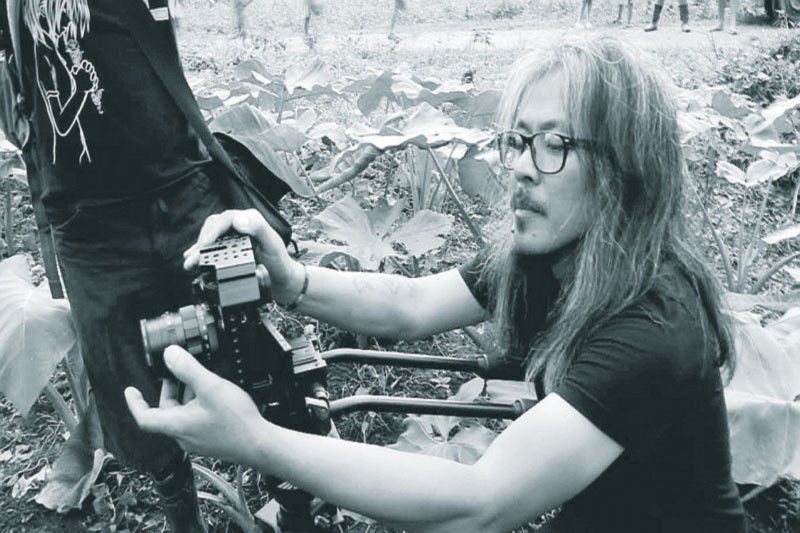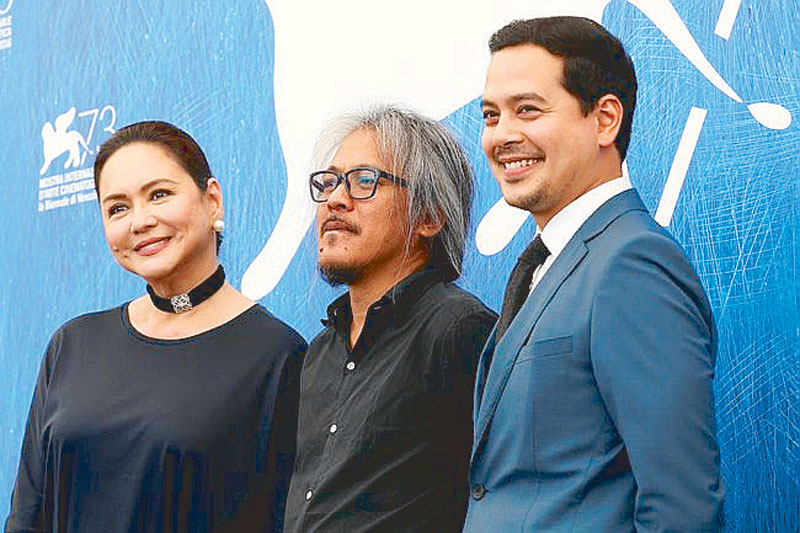Lav Diaz shares why his films involved big stars in book

Sine ni Lav Diaz: A Long Take on the Filipino Auteur, a book on the life and works of acclaimed Filipino filmmaker Lav Diaz, was launched on Monday by the Intellect Books (UK), De La Salle University, the Cinemalaya Foundation, Inc. and the Cultural Center of the Philippines, as part of the ongoing Cinemalaya 2021 film festival.
As the first book-length study on Lav as an auteur, it takes a comprehensive and critical look at his career and corpus through various viewpoints contributed by Filipino and international cinema studies researchers, film critics, festival programmers and artists.
The book acknowledged that while Lav’s contributions to slow and durational cinema, as well as his stature in contemporary world cinema are “well-known” and “beyond doubt,” the filmmaker — who discovered his love for cinema through his cinephile father who brought him to theaters near his childhood town in Tacurong, Cotabato to watch eight films a week — has been “largely unexplored in cinema studies.”
Sine ni Lav Diaz was edited by Parichay Patra and Michael Kho Lim. Patra serves as Film Studies assistant professor at the Department of Humanities and Social Sciences, Indian Institute of Technology Jodhpur, India.

Lim, on the other hand, is a lecturer of Media and Cultural Policy, and acting course director of the Master’s program in Cultural and Creative Industries at Cardiff University, UK. He is also the author of Philippine Cinema and the Cultural Economy of Distribution (Palgrave Macmillan, 2019) and the Assistant Secretary on the National Committee on Cinema under the Sub-commission on the Arts of the National Commission for Culture and the Arts.
In a virtual roundtable last Monday, Patra said it’s been a long, four-year journey for the making of the book. He was first introduced to Lav, via his film Century of Birthing, in 2011 during a filmfest section devoted to Philippine cinema in India.

After encountering more of his opus at the Melbourne International filmfest some years after, he contacted Lim about a possible collaboration because aside from chapters in books on cinema or special journals, there was no book-length study on the filmmaker. “That’s what made us interested in exploring the cinematic universe of Lav Diaz.”
Lim said that while their book mentioned Lav’s previous works (i.e. films for mainstream outfits like Regal) before he became independent, the contributors focused more on what has become his trademark — his slow and long cinema.
“I think what we are trying to present is that there are many forms of cinema and one of those types is a Lav Diaz film… so it’s basically widening our perspectives, and really trying to watch more of other types of films rather than just sticking to the more popular films,” Lim added of the goal of the film.

One of the engrossing parts of the book is Lim and Patra’s lengthy interview, A Lav Affair with Cinema, which began with Lav’s recollection of a “life-changing” moment in his life. He touched a movie camera for the first time during a filmmaking workshop that Ricky Lee sent him to at the Mowelfund Film Institute back in 1985. It was when he knew he would be a filmmaker no matter what “even though I was so poor that I couldn’t even buy a (camera) roll and a cigarette.”
Lav also talked about how he transitioned to digital filmmaking, starting with the film Evolution of a Filipino Family (2004), initially for practical reasons, but ultimately, felt empowered and liberated by the medium.
There were lengthy answers as well when asked about his decision to enlist big-name artists for some of his films, such as Charo Santos-Concio, John Lloyd Cruz, Piolo Pascual and Shaina Magdayao.
Lav noted in his interview with Lim and Patra, it was his frustrations with cinema — from whether his work was of any help to the nation’s struggles, to how he made many films but weren’t reaching the masses — that led him to include celebrities in his work.
“I want to push cinema more, push it to be part of the greater struggle. I ask popular actors to collaborate with serious filmmakers, to get involved in the struggle, to get people to watch the better works and realize that cinema is not just entertainment. And some of these actors’ eyes have opened. Their view of the medium changed in a big way,” he was quoted as saying.
He also said, “I think initially they did so out of some romantic notion: Who the f**k is this bum? When I met with them, I told them they needed to be responsible. They had a responsibility to their country, to humanity, to give back. I told them that they are cultural workers,” adding that as cultural workers they have an “important role to play in the bigger scheme of things.” And that is, to utilize “cinema as a tool to educate people on humanity’s struggle, on history, on truth.”
On Piolo, John Lloyd and Shaina, he further said: “I would like to think that after working with me, and with other progressive filmmakers, they have a better understanding of their roles now. That they are not just actors, that they are cultural workers, that it’s not just vanity and money, and that they have a responsibility to educate people.”
He also touched on John Lloyd’s sudden exit from the spotlight. The actor took an indefinite leave from showbiz in 2017, but continued to work on Lav’s films. The latest is Servando Magdamag.
“In the case of John, especially after A Lullaby to the Sorrowful Mystery and The Woman Who Left, he began to withdraw from the limelight. I am not saying that I influenced his decision to take a hiatus or to almost turn his back. He has his own mind, his own reasons. And I believe that he’d seen the problems in the system, he’d seen the industry’s malevolent side, greed, exploitation and decadence. Now, they’re more open working in independent cinema.”
He first learned of John Lloyd’s wish to work with him through veteran actor Ronnie Lazaro, while Piolo reached out through fellow filmmaker Joyce Bernal.
As for Charo, he met her at the victory party for Hele sa Hiwagang Hapis organized by ABS-CBN’s Star Cinema, the film distributor. The film then won the Alfred Bauer Prize at the 2016 Berlin Festival. He recalled being seated next to her and asking her if she still wanted to act after a 30-year hiatus, and she said yes, “if the material is good.” On the taxi ride home, he thought of what would eventually become The Woman Who Left for Charo. And according to him, she enjoyed shooting the film in Calapan, Mindoro because it was where she lived until high school. There, Lav said, she met with the people from her childhood and that her “attachment” to the place helped her deliver a “beautiful performance.”
Charo also stars in another Lav film, Henrico’s Farm, along with Shaina, Hazel Orencio, Angeli Bayani and Karen Haniel. The still-unfinished movie is about OFWs and based on his many real-life encounters with overseas Filipinos through the years.
In the book, Lav also disclosed that some filmmakers have frowned on his move to utilize star power in his films. “Having them on board won’t make you less cool. I know people who harbour that prejudice on popular actors...” he said, revealing that even comedian Vice Ganda was supposed to be part of his Ang Hupa. “It’s not cool when you shut out the big names, especially if they were offering help.”
These and other stories, essays and ruminations in the book Sine ni Lav Diaz.
Meanwhile, the book cover shows a photo of the director on his set of Ang Hupa (The Halt), taken by young filmmaker Cielo Bagabaldo. To get a copy of the book, visit https://www.intellectbooks.com/sine-ni-lav-diaz. For orders, https://artbooks.ph/products/sine-ni-lav-diaz-a-long-take-on-the-filipino-auteur-pre-order.
(Sine ni Lav Diaz book launch was part of the 2021 Cinemalaya Philippine Independent Film Festival, happening until Sept. 5. Watch the films in competition and exhibition via ktx.ph.)
- Latest
- Trending



























